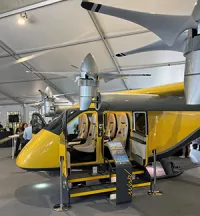
The next frontier of aviation is taking an exciting new direction, and TSA is in the middle of the action.
It involves large helicopter-type drones and is an amazing development in the future of flying and transportation security.
Advanced Air Mobility (AAM) is a rapidly emerging technology focused on safely and efficiently moving people and cargo in remote aircraft through devices such as electrical take-off and landing vehicles.
“Advanced Air Mobility technology is poised to revolutionize the way we think about transportation,” said Rob Rottman, TSA Policy, Plans and Engagement (PPE) Aviation Policy executive director. “This emerging sector offers the potential for safer, more efficient and environmentally friendly transportation, poised to transform both urban and rural landscapes worldwide.”
TSA representatives from PPE and the Law Enforcement/Federal Air Marshal Service (LE/FAMS) participated in the inaugural International Civil Aviation Organization (ICAO) AAM Symposium in Montreal, ICAO’s highest attended symposium in its 80-year history.
Underscoring the significance and worldwide interest in AAM’s future, aviation leaders gathered to discuss the challenges and opportunities of integrating AAM technology into the global airspace, emphasizing safety and security.
“As a security and law enforcement organization, TSA is actively leaning into this new mission space,” said LE/FAMS Executive Director Serge Potapov, who oversees LE/FAMS' various law enforcement threat and vulnerability assessment programs, including the Unmanned Aircraft Systems Unit. “We have a crucial role in ensuring the secure and safe adoption of AAM technology.”
The ICAO symposium offered aviation experts, including those from TSA, an opportunity to network and explore evolving security challenges and assess how TSA fits into the rapidly expanding AAM movement.
Rottman joined leaders from Airpol and several international organizations on a panel focused on security threats, vulnerabilities and risks associated with the development of AAM such as cyberattacks on automated flight systems and hostile actions against unmanned aircraft.
Rottman called on industry and government representatives to prioritize safety and security, while TSA and Airpol stressed the need for immediate action to prevent the misuse of AAM capabilities. They want to see comprehensive security measures to protect AAM-related air and ground transportation systems.
“Its (AAM) exciting possibilities promise to enhance connectivity and efficiency, but as we embrace this innovation, TSA must navigate the delicate balance between mitigating security risks and facilitating the immense potential of these transformative aircraft,” noted Rottman. “It is essential that we develop robust frameworks to ensure security without stifling progress, paving the way for a future where air mobility is both secure and accessible to all.”
Potapov also emphasized TSA’s proactive engagement in AAM conversations.
“We are still defining our role in the broader Advanced Air Mobility mission space,” said Potapov. “However, we are not starting from scratch. Our agency is already deeply engaged in both the use of drones and defending against their malicious use.”
By engaging with industry experts, Potapov said TSA is actively learning about the evolving AAM operating environment to understand where TSA fits in and how the agency can best contribute to ensuring safety and security.
“TSA is positioning itself as a key player in shaping international standards and practices for AAM security,” he added. “Our focus remains on safeguarding this revolutionary step forward in air transport, ensuring it develops into a secure and trusted mode of travel.”
Rottman said TSA’s active role in industry conversations highlights the agency’s commitment to understanding and addressing the unique challenges of AAM while also stressing, “We continue to build partnerships and contribute to the global dialogue to guarantee our skies remain safe and secure as we embrace this exciting new chapter in aviation.”
By Don Wagner, TSA Strategic Communications & Public Affairs



